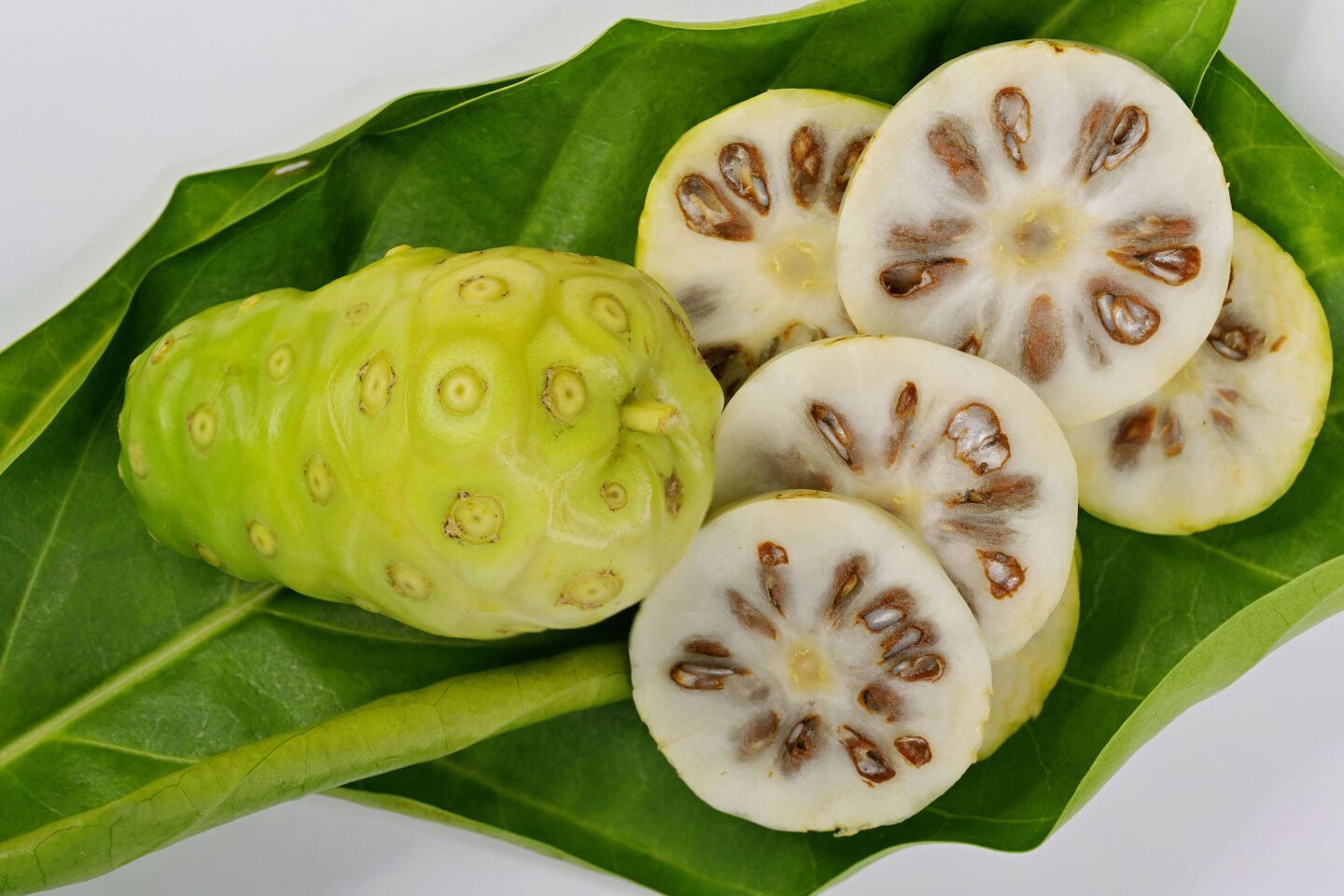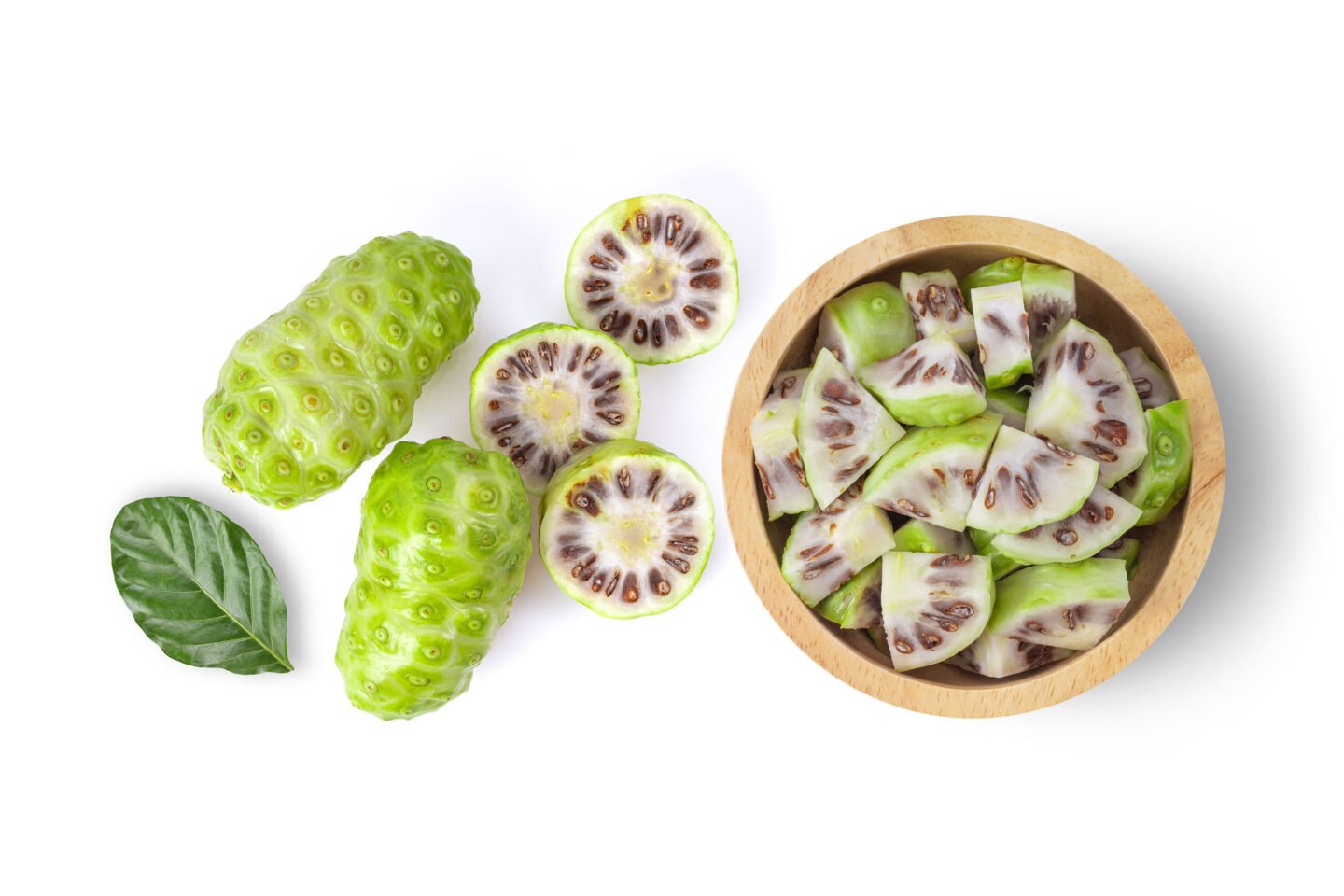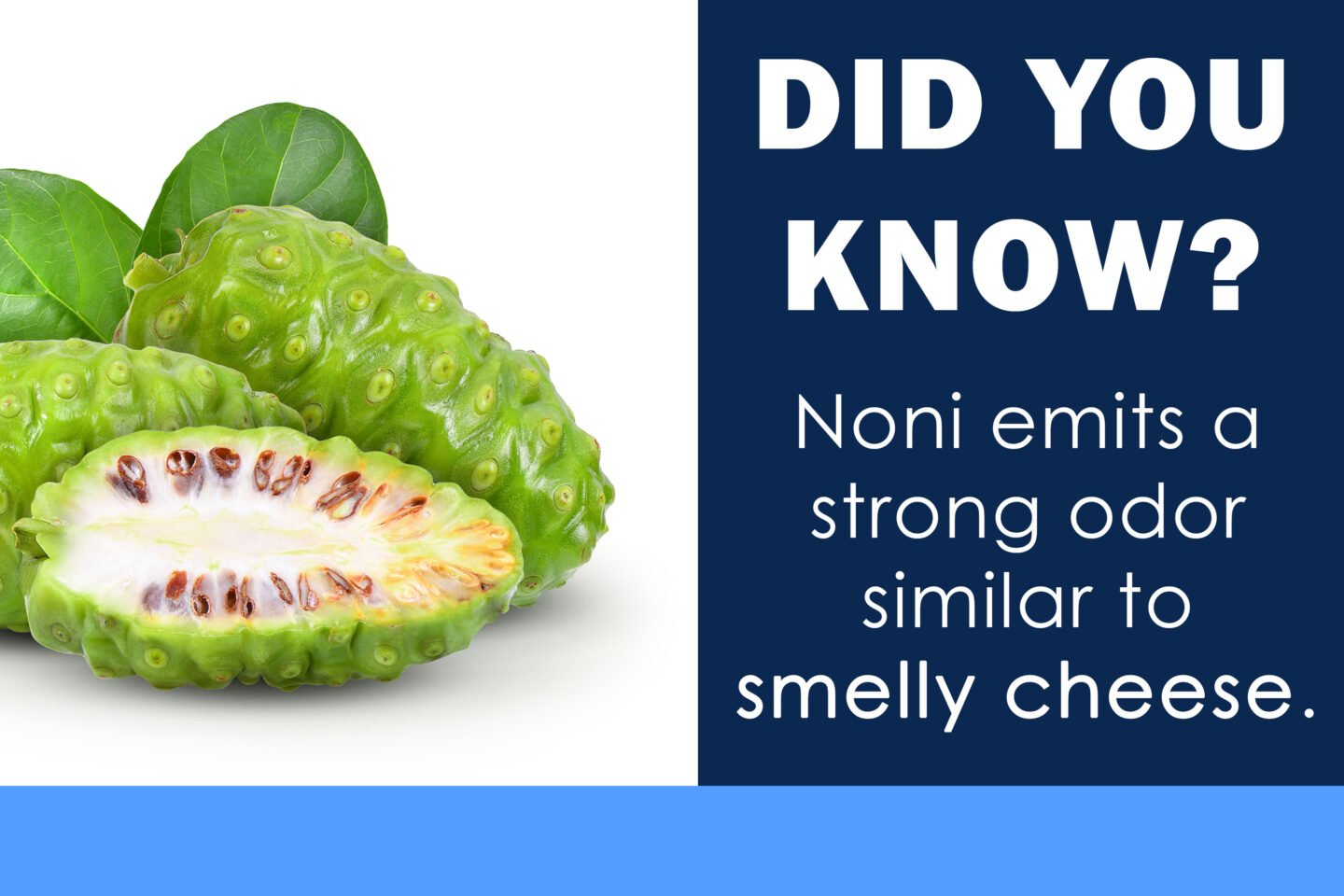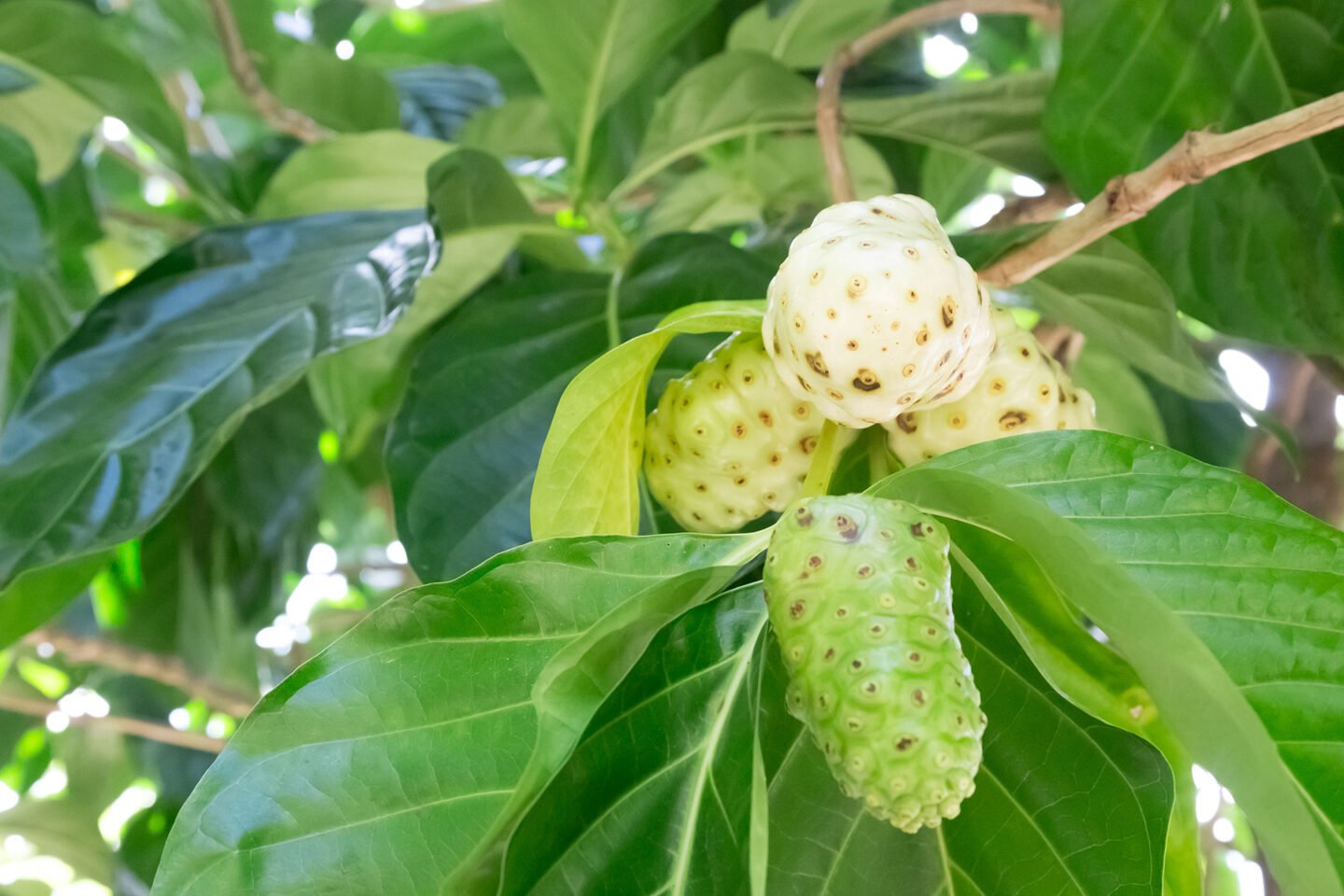The noni is a tropical fruit that is native to Australia and Indonesia but thrives in warm climates across the globe. Its bright green, dimpled skin and unique shape make it look like an organic version of a hand grenade. The delicate white flowers that protrude from them make for an impressive table centrepiece.

As the fruits ripen, they give off an overwhelming, pungent aroma that rivals the durian. So, if you see the fruit on a restaurant menu or are considering buying one at a market, you may be wondering what does a noni fruit taste like? Is the nickname “vomit fruit” justified? We’re about to take a close look at whether this exotic fruit is worth your money; we’ll also give a rundown on the juice as this is quite different from the fresh fruit. Let’s dive in and give it a try.
Table of Contents
Describing the Taste of Noni
Fresh noni fruit has a tart, sour flavor with a fetid undertone. It tastes like smelly ripened cheese such as Munster and shares similar flavor notes to fish sauce. The noni flesh provides a tingling, numbing aftertaste that is similar to the sensation of eating unripe pineapple.
The texture of a noni is firm like a jackfruit, and its juicy translucent flesh is riddled with seeds that make eating it out-of-hand a challenge. The seeds are similar to watermelon pips, but they have a tougher, more woody texture. Although they can be eaten raw, it is preferable to roast them before consuming.
Prefer to sit back and listen?
How Ripeness Affects the Flavor
Noni fruits are usually green when picked from the tree. They turn white during the ripening process. The fruit will quickly begin to ferment and rot, so you’ll need to keep a close eye on it.

Stage 1: Unripe
The benefit of eating green noni is that the pungent aroma is not so punishing, and the flavor is diminished. A common use for the fruit at this stage is adding its juice to a smoothie. There is a hint of cheesy flavor in the fruit at this early stage; there's also a grassy taste, with a spicy undertone. Take a drive through Mexico, and you’ll find street vendors selling this juice everywhere.
Stage 2: Ripe
Most people will eat noni when it is ripe. It is easy to know when the fruit is ready to eat; its skin turns white, and it gives off a funky odor that can be smelled from the other side of a room. At this stage, the flesh softens, and the cheesy, sour flavor notes intensify.
Stage 3: Overripe
As the noni fruit turns brown and begins to ferment, its flavor is so overpowering that it can’t be consumed on its own. The only option is to dilute it with other liquids or food. Most will find that eating overripe noni is an unpleasant experience.
Increase your fruit knowledge
Check out these delicious exotic fruits from around the globe:
Noni Juice
Extracting the juice from noni is an excellent option for getting the health benefits of the fruit without the harsh flavor. Place the uncut fruits into a large jar and allow them to ferment in the sun until the juice seeps out. This process will take two weeks or more.
The amount of liquid that is produced will be underwhelming compared to an orange, or practically any other fruit. A large jar may result in half a glass of juice. However, you only need to use a small amount mixed with other fruit in a smoothie.
If you drink noni on its own, the first difference you’ll notice is the strong smell is significantly reduced. The fetid flavor and astringent (tongue-numbing) properties are absent. The taste has mellowed out, but the levels of sourness and acidity will have increased – similar to a lemon.
Culinary Uses for Noni
Unlike some tropical fruit (we’re looking at you ackee), the noni is a much less risky food to eat. The fruit, seeds, roots, bark, leaves, and shoots can all be consumed; but the actual fruit is the most commonly eaten part. Peel the noni before eating as the skin isn’t pleasant.
- Slice the fruit into pieces and eat raw, spitting out the seeds like you would a watermelon.
- Add to smoothies, yogurt, or even oatmeal to get your daily dose of nutritional goodness.
- Add cubes of ripe fruit to stir-fries for a hit of sour.
- Cook chopped noni is casseroles to balance out a salty flavor profile.
- Toss raw pieces into an ulam salad for a flavor-packed dish.
- Include on a cheeseboard as a vegan cheese alternative.
- Thai cuisine uses the leaves as a vegetable in kaeng bai yo.
Health Benefits
In addition to eating fresh noni, there is also an increasing number of capsules, powders, and teas that use the fruit as its key ingredient. It is high in antioxidants and is a good source of vitamin C, biotin, and folate.

Fast Facts
- Noni is also referred to as "starvation fruit" as it was used in times of famine as emergency food.
- The fruit is a staple in the Pacific Islands for its health benefits. It is also popular in Southeast Asia and Central America.
- The noni (Morinda citrifolia) is a fruit-bearing tree that is part of the coffee family.
- Other names for the noni are cheese fruit, Indian mulberry, great morinda, and beach mulberry.
Do you love tropical fruit?
If you’re interested in lesser-known fruit types, then check out these links. We give you everything you need to know about the snakefruit, rambutan, the jaboticaba, and the pomelo. Find out about their flavor and texture, as well as their uses in the kitchen.
Summing Up
The noni fruit is unlike many other tropical fruits we’ve reviewed. It’s hard work eating them raw. The combination of acrid smell, pungent flavor and endless seeds are the reason most find them unpleasant. Admittedly, some foods grow on you over time – maybe that’s the case with noni fruit?

Do you want the nutritional goodness from a noni? Your best option is to drink it in liquid format. Commercial bottles of the juice don’t have the same “funky factor” and are more palatable. Keep in mind they may add sweeteners and other ingredients to help cover up the flavor. Always read the nutrition label to get the full picture. As an alternative, you can also get plenty of goodness from a jazz apple, dragonfruit or banana. That's the option we'll be taking from now onwards.
Have you ever tasted noni fruit? What was your experience with this fruit? Let us know in the comments below.
References:
https://www.ncbi.nlm.nih.gov/pubmed/17162334
https://en.wikipedia.org/wiki/Morinda_citrifolia

Leave a Reply